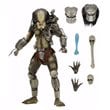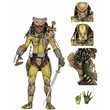The Unlikely Success of the Predator Franchise
This month saw the release of The Predator, the latest film in the sci-fi creature feature franchise that started back in 1987. I haven't seen the new film yet, but I have been looking over the reviews to see how critics have reacted to the newest installment in a film series that celebrated its 30th anniversary just last year. Of course, most of the critics have been dismissive of the movie, which I've come to expect from critics when they talk about monster movie sequels. However, based on what I know about the franchise as a whole, it surprised me how much most critics don't know about the Predator series. If they did, they wouldn't be asking why Predator movies keep being made even though they don't make blockbuster amounts of revenue at the box office.
Predator arrived in the middle of Hollywood's string of testosterone-laden, macho action star-driven adventure blockbusters during the 1980s, blockbusters that banked on the appeal of stars such as Sylvester Stallone and Mel Gibson and defined by films such as Bloodsport and Die Hard. Predator was, for all intents and purposes, an Arnold Schwarzenegger movie. It relied heavily on his star power, both on the silver screen and in the film's marketing campaign; when Schwarzenegger declined to appear in Predator 2, this franchise should have been over after the first sequel underperformed at the box office.
A star from beyond the stars: Kevin Peter Hall (left) and Arnold Schwarzenegger.
Unlike other action film blockbusters from the '80s, Predator had another star: the titular monster himself. Designed by Stan Winston and portrayed by Kevin Peter Hall, the monster's convincing appearance and behavior sold the film's central plot thread--a space-faring, heavily armed hunter who likes to kill humans for sport--all the way to the film's end credits, a thread that would've unraveled beyond repair if the monster looked like some guy in a hokey costume. Thanks to the work of Winston and Hall, pop culture gained a new icon that could build its own fan base without any additional involvement from Schwarzenegger.
If Schwarzenegger, Winston and Hall introduced the Predator to the public, the comic book company Dark Horse kept him coming back to the fans for the next few decades. The content of these comic books (some of which were adapted into novels) would greatly influence the monster's appearance in other areas (toys, video games, and licensed merchandise). In fact, many have argued that Predator 2 owes its overall plot and many of its ideas to Concrete Jungle, Dark Horse's first Predator miniseries.
Cover art from Predator: Concrete Jungle.
Dark Horse was also the first to pair up the Predator with his greatest co-star: the Xenomorph from the Alien franchise. When the pairing first appeared in the original Aliens vs. Predator comic book miniseries, it was so popular that it has become its own semi-franchise, with video games, action figures, and two feature-length movies; in fact, most of the Predator's appearances in video games are in the context of an Aliens vs. Predator title. It should also be noted that even though the Predator is capable of space travel, he is more likely to be seen on another planet in a Dark Horse Aliens vs. Predator comic book than in a Predator comic book.
If anything, the Predator franchise defies the rules of what attracts the most fans to what is nominally known as a movie franchise. In most other movie franchises, only the movies are considered to be canon while the licensed comic books, novels and video games are not canon and are subject to invalidation at any time by the movies. In contrast, much of the lore that defines the Predator and his background has come from the comic books. This does not mean that the movies are completely irrelevant to the Predator franchise; in fact, giving the franchise to a filmmaker with a bold, creative vision could work wonders for the series. Yet when it comes to the Predator, the movies are just one part of a larger, multi-media franchise where movies are not the primary means of keeping the fans engaged.
NECA's Predator action figure line, which includes characters based on Predator movies,
comic books, video games, fan films, and other action figure lines.
This wouldn’t be the first time that movie monsters found a home in comic books. For example, in order to cash in on the “monster kid” craze during the 1970s, Marvel published a selection of comics (e.g., The Tomb of Dracula, Werewolf by Night, The Living Mummy, etc.) that were intended to bear strong similarities to Universal’s lineup of classic movie monsters. Nevertheless, I can’t think of any other movie monster that has depended upon comics to build and maintain a fan base as much as the Predator.
There are plenty of critics out there who believe that box office performance of The Predator will determine the future of Predator franchise. Yet the same thing was said about the previous two sequels, and that didn’t stop Dark Horse and other companies such as NECA, Sideshow Collectibles, Hiya Toys and others from profiting from the Predator. The most likely path forward will be that the creature designs that are specific to The Predator will appear in a number of merchandising lines for the next few years until the next high-profile Predator media project (a movie, a video game, or something else) is greenlit by Fox (or whoever own Fox’s creative properties by then). Such a future may baffle film buffs, but it happens to be the kind of future that’s common for classic movie monsters. If that isn’t a sign of success for the Predator, I don’t know what is.
Related Products:










Comments
Post a Comment